November 03, 2010
By Bill Marchel
Stranger Than The Sora Is The Hunter That Chases Them.
By Bill Marchel
Toss a fist-sized rock into almost any freshwater marsh or slough and at the splash you'll likely hear a resounding "peep" from a secretive little game bird called a sora.
Launch a boat into the same marsh, load it with two hunters, a dog and a push-pole, and you have the makings of a sora hunt.
Wait a minute. Why would a cryptic bird like a sora--a bird that is rarely seen if not purposely pursued-- announce its presence to the world with a loud "peep" when a stone splashes nearby?
It's an odd trait displayed by an equally odd bird. Mother Nature is a mad scientist.
Advertisement
Even more peculiar than the sora--and much more rare--are the hunters that pursue these fist-sized marsh birds, but that is exactly what a few friends and I do each fall.
Advertisement
Sora Facts
The sora is a member of the Rallidae family, which also includes coots and rails. Soras are common in freshwater wetlands across most of the U.S. The small, plump, nine inch-long soras have yellow beaks and stilt-like green legs with long toes that enable them it to scoot across the water on matted vegetation. Soras will occasionally swim short distances over open water, and will sometimes dive under water to escape predators. This mysterious bird eats a variety of seeds including wild rice, insects and snails.
I live in Minnesota, and the hunting season for soras begins on September 1 and closes in November. Soras, like blue-winged teal, migrate early, and since a late summer cold snap can send them southward, we hunt soon after the season opener. We often pursue soras in the same wild rice marshes in which we hunt ducks a few weeks later, so the sora hunts double as scouting trips for waterfowl.
We aren't the only predators seeking a sora supper. Lurking beneath the wild rice, cattails, lily pads and duckweed in which soras live are largemouth bass and northern pike.
Last fall I watched a sora hotfoot across the water's surface just a few feet in front of my boat when suddenly the water exploded. The retreating bird disappeared into the maw of a bass.
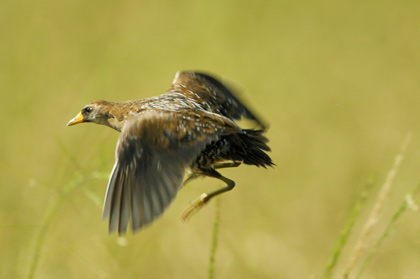 Flushing a sora remains the toughest challenge... |
A friend once noticed, during the task of removing a hook from the jaw of big bass, the green feet and legs of an unfortunate sora protruding from the gullet of the fish.
So, along with our shotguns, we often toss fishing rods into the boat--a cast-and-blast for bass and soras.
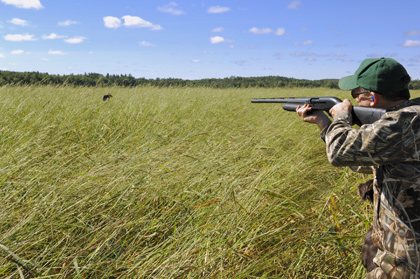 ...but downing them is most often a breeze. |
Finding 'Em
Finding soras is usually not difficult, but getting them to flush from heavy vegetation can be an effort. I have found the best method is to have one hunter poised in the bow of the boat with gun in hand and dog at his side, while the other poles the craft through thick stands of wild rice or cattails. Soras have a habit of running ahead of danger, so the boat must be propelled at a speed sufficient enough to pressure the birds into flight. A ploy that has worked for us is to attempt to "drive" soras toward open water to get them to flush.
For example, wild rice often grows in long fairly narrow "fingers" with open water on each side and end. Soras, often invisible in the thick rice, will skedaddle unseen ahead of the boat as we push them toward the tip of the finger. At that point they run out of cover and are forced into the air.
Soras are often scattered in loose bunches of three to six birds--what I assume are family groups. When one bird flushes, there are usually others nearby. On a number of occasions I've witnessed three four birds in the air at once.
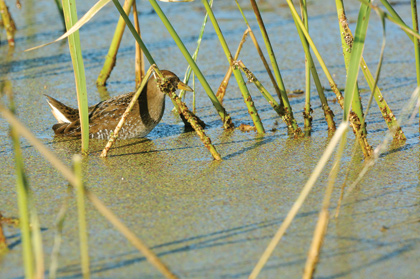 Soras tend to hide in the thick stuff. |
When hunting in especially dense cover, if the water is shallow enough, sometimes one man will jump overboard and push the boat. Anyone who has ever walked in a wild rice bog knows how difficult that can be. If the average potbellied American depended on sora meat for sustenance, well, we'd all have the physique of a certain California governor.
As difficult as soras are to flush, they make equally easy targets once they are in the air. Their flight appears labored, and it's amazing to me that they manage to migrate each spring and fall. The trick is to shoot quickly. If you drop a bird too far from the boat, it can be hard to find in thick vegetation.
Of course, a good dog is almost mandatory for finding downed soras. The small birds can be a tough retrieve for a dog. Since a dead sora barely floats, I would imagine they give off very little scent, and because of the tall vegetation in which soras live, a dog seldom sees a bird fall.
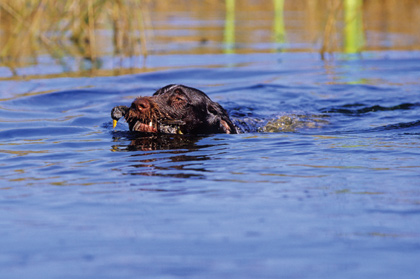 Take the edge off of you and your gun dog with an early-season sora hunt. |
My colleagues and I always carry a bucket of rocks when hunting soras. As I mentioned earlier, soras will usually "peep" when a stone hits the water. We also employ tossed rocks to help a dog find a downed sora in heavy vegetation. A stone lobbed to the spot where a sora dropped will help guide a dog to the fallen bird. My current dog Axel, a male Deutsch Drahthaar has learned to watch for a thrown rock, and listen for its telltale splash, if he did not see the bird fall. Only once has he retrieved the rock.
If you scoff at this technique, thinking a hunting dog should be guided by hand signals, so be it, but remember soras inhabit the nastiest cover and often the dog is out of sight as it struggles and splashes, half swimming, half lunging during a retrieve.
 If forced, soras will swim from one patch of cover to the next. |
A few years ago I took an outdoors writer on his first sora hunt. Once on the water, and when the writer had his gun loaded and ready, I pitched a stone into the nearby marsh. Several soras peeped. One especially jumpy bird flushed, but before the writer could fire a shot, the sora landed on a lily pad about 15 yards away. "Get ready," I told the writer and I threw a stone toward the bird hoping to flush it.
Yep, you guessed it. The rock smacked the bird killing it stone dead. My dog Axel saw the splash, and like a good dog that he is, disobeyed my "stay" command and leaped into the water. The eager dog promptly brought the sora to boat-side where I grabbed him by the collar and hauled him and sora aboard. "One sora in the bag and zero shots fired" I said as I showed the writer the bird. "I'll just leave my shotgun in its case."
The writer never did mention my stone-pitching skill in his story. I suppose he wondered about the legalities of hunting soras by throwing rocks. I wouldn't tell this yarn had I not had him as a witness.
Soras, like other small game birds such as doves and woodcock, don't require heavy loads to bring down. We use size seven steel shot propelled from our typical waterfowling guns, which we equip with open chokes. Twenty-five yards is considered a long shot.
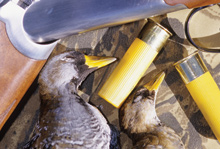 Light loads and open chokes: a perfect combo for taking the secretive sora. |
Conclusion
Sora hunting is a great way to get your dog in tune for the fall waterfowl-hunting season, or to introduce a young dog to life in a boat. The water is warm, the hunting casual. It's also a good time to de-bug your duck hunting boat and other gear prior to waterfowl season.
As table fare, soras compare to other game birds with dark breast meat such as woodcock and sharp-tailed grouse. Usually on the evening of sora hunt, I'll marinate the breasts and grill them shish kabob-style with red peppers and onions. And I would sit chin-deep in a hot tub--if I had one--to soak out the kinks.

